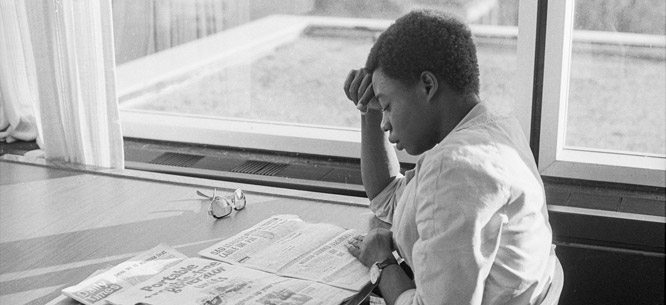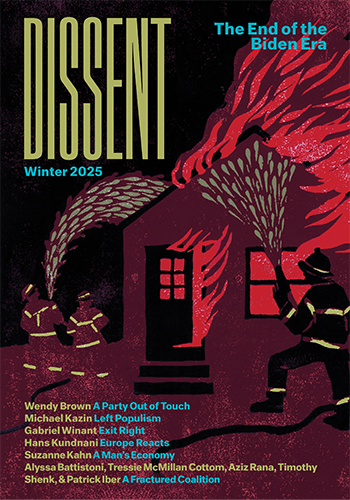Why We Need a Working-Class Media
Why We Need a Working-Class Media
What could the political effects be of a media that actually served working-class Americans?

1.
I came up with the Statue of Liberty close at hand, seeing her on clear days and nights from the high-floor window of my childhood apartment in Queens. Down on brown knees with elbows resting on the sill, I’d take in this postcard view of the Manhattan skyline, just about making out the lady’s outstretched hand. I was twenty miles away, a distance that also spanned the leap between my household and those glimmering spires of wealth, security, and different worries.
The leap seemed possible to me because, well, why wouldn’t it? I was that kind of kid. And in school I was learning that the Statue of Liberty is a 24/7 broadcast of a powerful story: in America, poor immigrants can close those twenty miles.
I’d emigrated with my mother from Barbados in August 1986 when I was nine. As a child made hyperaware of my foreignness to the point where I didn’t mention it in native-born company, I attached to the fact that Lady Liberty was talking to people like me. I liked looking for her outstretched hand. I now see her as lighting my seat at the long table, as it were. She anchors me. But between realizing that the American dream is a lie, especially for the poor and the working class, and rising xenophobia and gains for the wealthy under President Donald Trump, my place has never felt less secure.
For some time, I’ve hoped to be similarly anchored, or seen, by other American media—because what is Lady Liberty if not permanent advertising? Social media is an open forum for intra-group voices and disagreement, but beyond, flattened stereotypes prevail. “The working class” is white, male, parochial. “Blacks” appear in relation to oppression; as race unicorns (The Extremest Highestest Achieverers of any field); or as forever-scolds holding white people to account. “Immigrants” are asylum seekers, criminals, or holders of H-1B visas. Rarely do I see stories by, about, or for people like me: people who are working class and black and immigrant and woman or woman-identified.
I’ve learned that it’s anachronistic to believe that a person can climb out of the working class by getting a good job or becoming a professional. Set aside my generation’s downgraded definition of a “good job.” Mobility requires intergenerational wealth or assets that allow you to recover the high costs of striving in the first place. These high costs include: student loans; healthcare; years doing unpaid or poorly paid internships; lifestyle and rent expenses to fit into upper-middle-class networks; and elder or other family or community care responsibilities.
The 2020 election will reverberate for another generation, not just another term. I wonder about the potential political effects if we had a media that served working-class Americans of this economic era, who currently feel typed but not seen.
Just as black media did with “black” in the 1960s, I want a cultural and political space for the actual “working class.” I like economist Michael Zweig’s definition in his 2000 book, The Working Class Majority. It is “made up of people who, when they go to work or when they act as citizens, have comparatively little power or authority.” By his broad measure, based on an analysis of Department of Labor occupations, the working class constitutes 62 percent of the U.S. labor force. I want a prominent media home that reflects our size and heterogeneity. I want stories about wealth as opposed to income inequality and its effect on intergenerational and social mobility. I want stories that aren’t just about our problems, but that are also told by, for, and with us. We are civic participants who matter. I want us to set the terms of debate.
2.
In any modern hunt for full, accurate representation of “the working class,” the nigger in the woodpile, of course, is race. Can the white working class ever be not racist? My musing isn’t without merit, but I’m also wary when mainstream coverage dwells on a single story about a group of people. By income the typical Trump voter, for example, isn’t even working class. Even without college degrees, they earn more than the median national income. Trump voters are more likely to be comfortable, white, middle-class, mainstream consumers. But I suppose “the suburban gentry” isn’t as easily stereotyped or sensationalized as low-income whites. Class prejudice toward the latter is almost the air we breathe in our society, and that bias has long infected press coverage.
In No Longer Newsworthy: How the Mainstream Media Abandoned the Working Class, Christopher R. Martin shows how, since the late 1960s, journalism has practiced a “class-based redlining of the news audience” that effectively disappears working-class people and our communities. One result is that most readers today “would not learn much about the working class from the news media.”
Popular writing about class, a welcome post-Occupy trend, has flourished since Trump’s election. However, other than sociologist and essayist Tressie McMillan Cottom, I struggle to name popular black (or other non-white) class writers. White bylines come to mind: Sarah Smarsh, Sarah Jaffe, Connie Schultz, George Packer, Heather Bryant, David Leonardt, J. D. Vance, Joan C. Williams. Unwittingly or no, the lack of diversity reinforces the false narrative that “class” is a white concern.
Similarly, when black writers talk about class issues, like student loan debt or the cost of higher education and housing, they’re typically presented in relation to black people only. This carve-out is facilitated by “racial disparity” data that support a single story: broad black–white comparisons rather than intra-class racial comparisons or intra-racial class comparisons. It’s not that the racial disparities formula isn’t relevant; it’s a truism that whatever goes wrong for white folks goes worse first, faster, and furthest for their black counterparts.
At the same time, though, a sizable black and brown middle class has choices, opportunities, and cultural touchpoints that may be more in sync with their class than with their racial peers. If the criminalization of blackness weren’t still a white American nervous disorder, how much would the black middle class have in common with their low-income racial counterparts? Broad racial disparity data don’t address intra-class similarities or differences. And neither does it invite the class narratives of 40 million black and brown immigrants and their children. We hail from countries where class identity matters as much as race, ethnic, or religious identity.
In sum, up and down the class ladder, all skinfolk ain’t kinfolk. Saturday Night Live, in the tense weeks before November 2016, featured Tom Hanks as a stereotypical Southern red neck, the only white contestant, on Black Jeopardy. The skit captures a lonely, almost shunned idea: that there’s more crawl space between same-class racial groups than is popularly imagined or broadcast. I crave a news media that explores that territory. Such an evolution won’t come from existing institutions, however. The weaponization of identity and foreignness in this presidential election cycle is already making past dog whistles seem quaint. Yet newsrooms, according to a 2018 Pew Research Center analysis, are 77 percent white. After two decades of consolidation, downsizing, and buyouts, they also tend to be middle-class and up. At worst, they are out of touch; at best, short-handed and unprepared.
3.
Suppose 90 million voters sat out the last election in part because news media engages a reality in which they do not live? In her 2018 book The Marginalized Majority: Claiming Our Power in a Post-Truth America, journalist Onnesha Roychoudhuri writes about progressives but her observation can apply to the working class, regardless of political affiliation: “For too long we’ve accepted stories that disenfranchise us even when they fly in the face of facts, logic and our . . . reality.” We lose every time the wealthy set the terms of discussion and tell their stories of us.
In 2015, the Detroit Free Press ran a viral story, headlined, “Heart and sole.” It profiled a “heroic” black man who lived in Detroit but walked twenty-one miles every day to and from a factory job in a majority white suburb. “But you won’t hear him complain—nor his boss,” the journalist wrote.
In 2018, after the suicide of fashion designer Kate Spade, the New York Times described buying her handbag as “a coming-of-age ritual for a generation of American women.” Like many others, I paused at this unlikely U.S. norm. “Who is in the newsroom often determines what experiences are broad enough to be universalized in stories. Does that include buying a handbag which costs more than a quarter of the American woman’s median pre-tax weekly income of $783?” asked journalist Farai Chideya, in the Columbia Journalism Review.
This June, the New Republic advertised its search for an Inequality Editor “who can go into the 2020 elections raising hell.” Following a stated commitment to pursuing diversity and hiring people with criminal records, the job listing informed applicants this would be a non-union, “part-time role, requiring 29.5 hours a week, and does not include benefits.” After the Twitter public shamed the publication and its nascent union co-signed, the magazine amended the advert.
I could go on. The evidence of media’s disinterest in actual working-class realities comes as a steady drip. It adds up to a narrative of a disenfranchised, neutered working class, trotted out for affluent readers interested in poverty or angry populist stories. For too long, we’ve settled for being written about but not for.
4.
We need a corrective. I want to propose three minimum components for a new working-class media.
The first is anger. The United States is now a country where Forbes magazine, without irony, describes twenty-one-year-old Kylie Jenner as a “self-made” billionaire. Stories matter in culture wars. I’m not yet accustomed—and neither do I want to be—to the well-off stealing my Horatio Alger tale of ascending a slicked-up class ladder. I can imagine that others in the working class, similarly shaped by watching our parents or guardians sacrifice for us, might also feel disoriented, if not disgusted, when media avatars of privilege appropriate our uplift narrative.
Second, we need a view of society and ourselves from the underside of power. So much of my coming of age in the United States filters through the lightness that my single mother lost in those early years when she worked as a low-level administrative assistant. She laughed less, watched more. My first winter coat in the United States was too thin. It was a knee-length pretty pale lavender with a chevron stitch-pattern but not enough puff. It was a shitty winter but why guilt her? I knew she was doing her best.
Early on I saw how easily an individual can be disappeared into a disregarded mass because of how you look, your accent, or lack of formal education. I learned how family and community are treated when little people with big authority believe you don’t have power: police with their guns, teachers with their words, social workers with their notes, government workers with their gruffness, politicians with their talk, researchers with their knowledge, doctors and nurses with their contempt. It’s not that these occupations or people are bad. It’s that they have power over others, and those on the underside know it’s easily abused. These childhood lessons fundamentally shape the perspectives of adults who grew up in poor and working-class households, regardless of current political affiliation or how much individual income they might earn.
Third, the working class must appear in our media as more than a problem to be solved or studied. I look to the UK where writing about the class system is as common as writing about race in the United States. Even there, though, only our struggles draw mainstream attention, writes Kerry Hudson in the Guardian, adding, “The ‘working-class experience’ is as broad and varied as anything you could call ‘middle-’ or ‘upper-class.’” Economic hardship does not mean the absence of joy, love, pleasure, duty, care. Just as black folks disengage from media that only makes room for black pain, the same can be said for the working class—particularly young people—watching one-dimensional representations of their lives.
5.
The Statue of Liberty is pulled out once a year for fireworks and even that seems rote. She supposedly belongs to early waves of poor European immigrants and their post-1950s, now middle-class and wealthy, descendants. I was born in the late 1970s, and she’s rarely if ever discussed in relation to my Gen X–millennial-cusp cohort, and even less, my turn-of-the-century immigrant cohort from Asia, the Caribbean, and Latin America.
But so what? Demographic change and wealth inequality mean new stories about what it means to be working class are here. Let’s write them—on our terms.
Carla Murphy is a writer working on a book about class mobility. She lives in Brooklyn. You can follow her on Twitter @carlamurphy or reach her through her website www.carlamurphy.com.
This article was supported by the Economic Hardship Reporting Project.




